Biodiversity
According to information from the Ha Long Bay Management Board, Ha Long Bay is located in a geographical area connected to Bai Tu Long Bay and Cat Ba archipelago, forming a sea and island complex with many favorable natural conditions to form a diverse system of sea and island habitats. This is the basis for the formation of biodiversity for Ha Long Bay. Scientists have assessed Ha Long Bay as one of the areas with high biodiversity value. The biodiversity value of Ha Long Bay is reflected in the diversity of ecosystems, diversity of rare genetic resources and diversity of species composition.
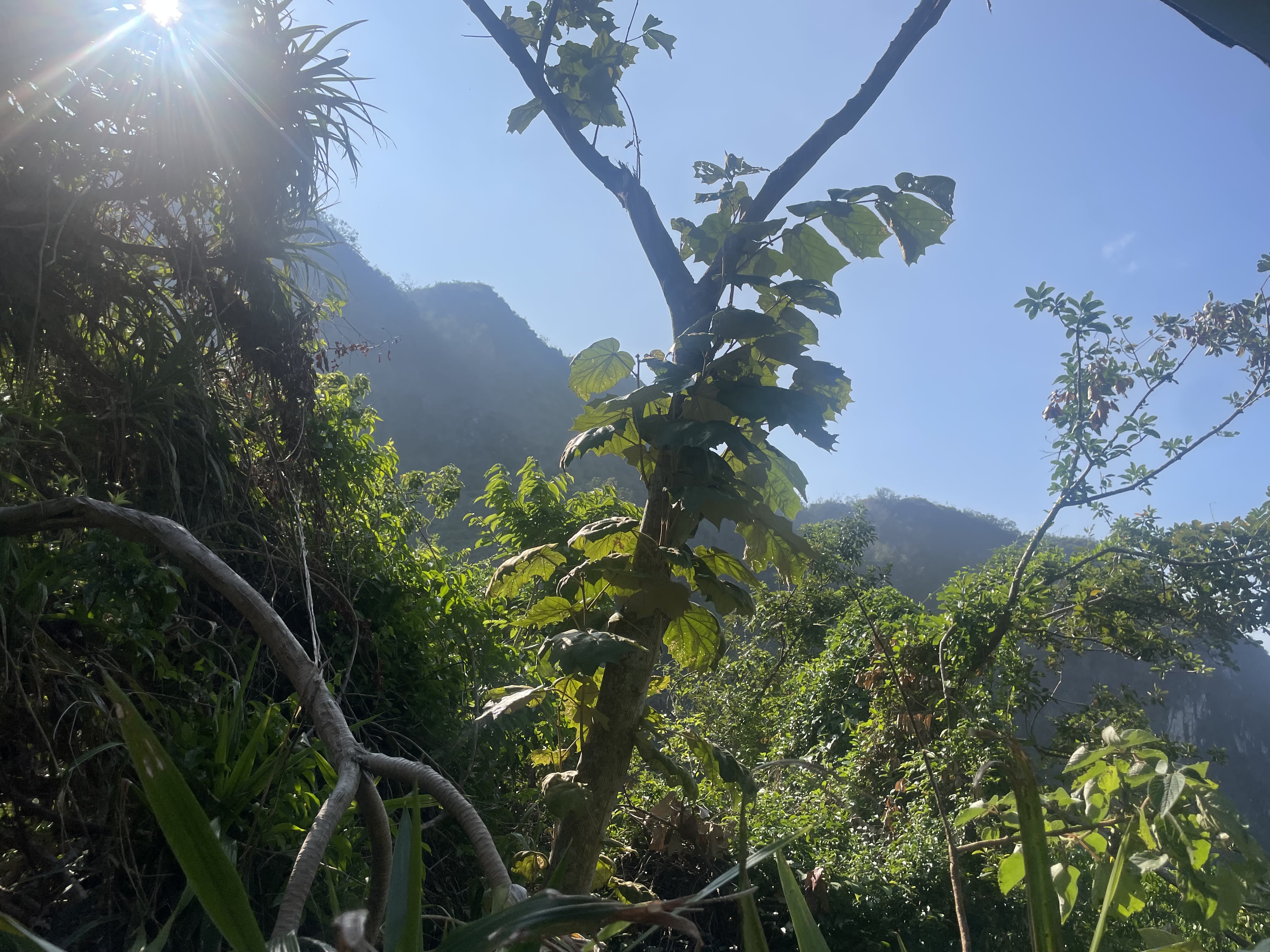
Diverse ecosystem in Ha Long Bay.
According to the Ha Long Bay world natural heritage dossier of the Department of Cultural Heritage (Ministry of Culture, Sports and Tourism), the geological environment formed from Karst terrain is the foundation for the development of other values of the Bay, such as biodiversity, archaeological culture and other human values.
Statistics from the Department of Cultural Heritage show that the total number of plant species living on the islands in Ha Long Bay is about more than 1,000 species. Several different plant communities have been found, such as mangrove species, plant species on the sandy shores of the islands, species growing on mountain slopes and cliffs, on mountain tops or growing in caves or crevices.
21 rare terrestrial plant species recorded in the Red Book are found in Ha Long Bay:
The power of immortality
The phoenix tail
Label
Lemongrass
Mountain enemy
Fairy flower
Root
Letter
Northern locust
Zombie Coin
Hairy code
Scattered Coins
First lime pot
The leaf of the tree
Rau sang
King pine
Cotton
Cheesy
Many leaves
Turmeric
Hundred steps
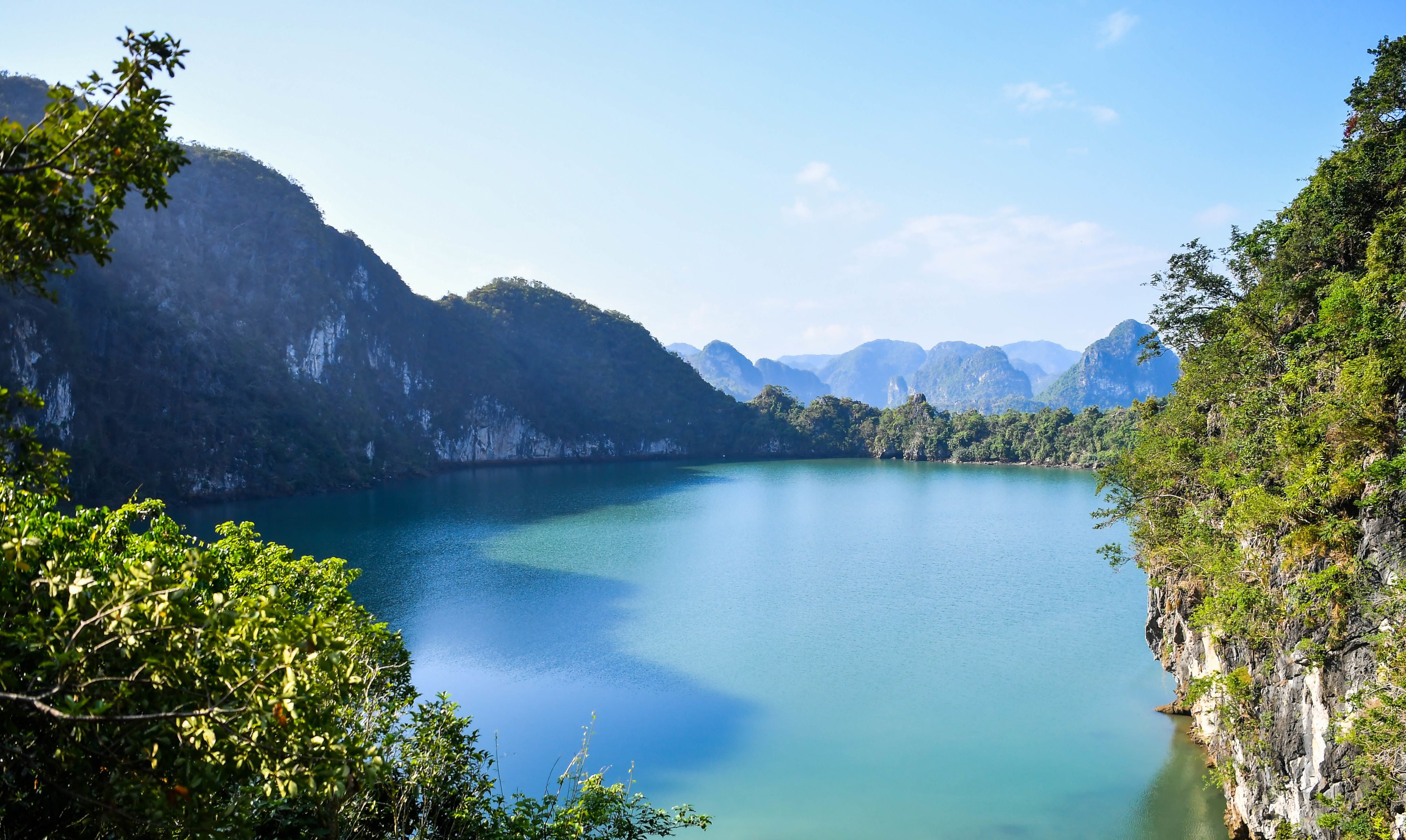

Golden flower Venus. (Photo: Bay Management Board)
Researchers of the International Union for Conservation of Nature (IUCN) have discovered 7 endemic plant species of Ha Long Bay. These species are only adapted to live on the limestone islands of Ha Long Bay, and are found nowhere else in the world, namely: Ha Long cycad, purple bitter melon, Ha Long palm, velvet bitter melon, Ha Long ear-shaped plant, Ha Long ivy, and yellow-flowered lady's slipper.
17 endemic plant species of Ha Long Bay have been discovered so far:
Five-leaf ivy Ha Long
Ha Long Palm
Ha Long Year
Ha Long Water Polo
A pair of Ha Long civets
Ha Long Civet
Ha Long civet
Ha Long temperate civet
Ha Long Bay
Ha Long figs
Ha Long cold rice
Ha Long Jasmine
An Dien Ha Long
Ngoai Moc Tai Ha Long
Nan Ong Ha Long
Ha Long galangal
According to statistics, the evergreen, tropical rainforest ecosystem in Ha Long and Bai Tu Long has: 477 magnolia species, 12 fern species and 20 mangrove plant species.
Some plant species have been propagated by the Bay Management Board and have given good results. Among them, Ha Long Palm was built into a scientific project by Ha Long Bay Management Board and has been successfully propagated to plant on some islands of Ha Long Bay such as Hang Trai, Cat Lan, Ti Top... Ha Long Palm has also been propagated by Cat Ba National Park to plant on Cat Ba Island.
In addition, Ha Long slipper orchids have also been initially successfully propagated with 100 plants on the slopes and cliffs in Cong Dam and Cua Van. Up to now, there have been about 600 slipper orchids in these two areas growing well, adapting to the new living conditions, creating beautiful landscapes.
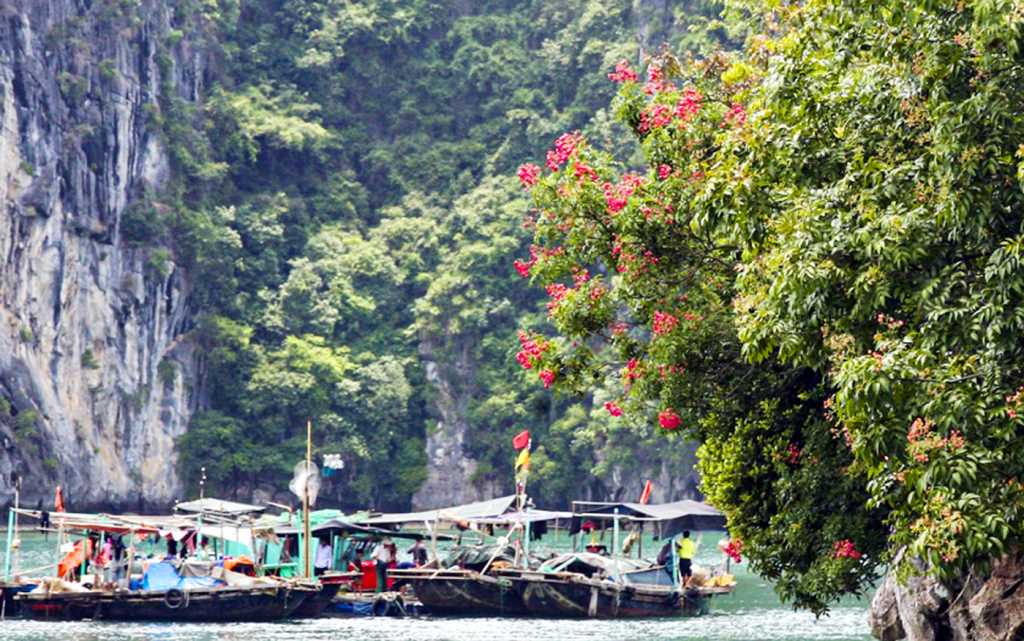
Cotton trees bloom brilliantly on Ha Long Bay. (Photo: Quang Ninh Provincial Information Center)
The Ha Long Bay Management Board has also actively and successfully researched the growth characteristics and propagated and preserved the cotton tree, a narrow endemic species in the Vietnam Red Book. Thanks to that, up to now, the tree species with beautiful flowers and fruits growing in clusters has been planted in large patches, showing off its colors at points on the tour itinerary such as: 200 trees in Dau Go, Hon Luot; more than 100 trees in the islands of Sung Sot, Titop, Me Cung, Bai Dong...
The characteristic of endemic plants in Ha Long Bay is that most of them grow precariously on the top or cliffs, their roots cling tightly and deeply into the crevices of the rocks to survive. There are species of flowers that bloom in spring such as Ha Long Palm; there are species that bloom in summer such as Purple Bitter Melon, Ha Long Cycad… These species of plants are adapted to the environmental and climatic conditions of the islands in Ha Long and have not been found anywhere else in the world.

Halong Bay.
Other endemic plant species in Ha Long Bay are likely to be added more, because up to now there has not been a truly complete and comprehensive research project on plants on all the islands of Ha Long Bay and the surrounding area...
As for animals, 4 species of amphibians, 10 species of reptiles, 40 species of birds and 14 species of mammals have also been recorded.
Research results over the years show that in Ha Long Bay there are over 300 species of fish, 545 species of marine animals, 154 species of coral, 35 species of plankton, 139 species of seaweed, 5 species of seagrass and 31 species of mangrove plants...
Scientists also discovered some endemic animal species found only in Ha Long, such as the Ha Long loach, scientific name Draconectes narinosus, discovered in Duc Tien cave on Van Gio island, a small island with long and narrow sections, the widest part is only about 400m.
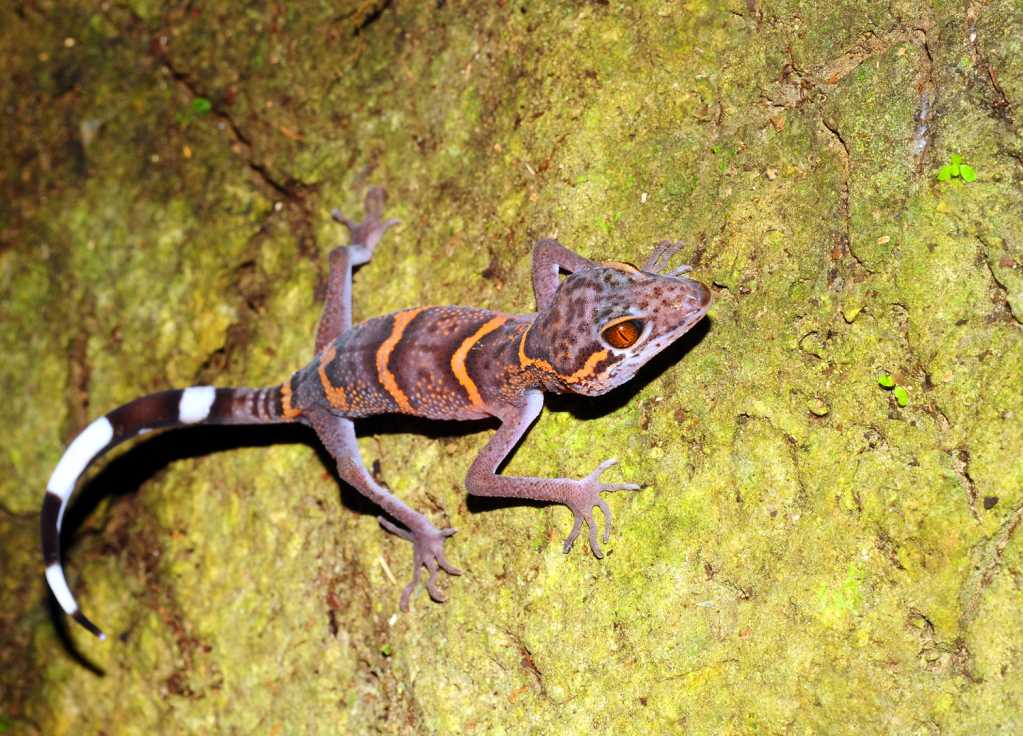
Eyelid gecko in Ha Long. (Photo: Quang Ninh Provincial Information Center)
In addition, there is also the Eyelid Gecko, previously only recorded on Cat Ba Island. This species was discovered by a survey team of the Vietnam Museum of Nature (Vietnam Academy of Science and Technology) and the Ha Long Bay Management Board in 2016 and 2018, on some islands in Ha Long Bay. Through the research and fieldwork process, this information was identified and published in the prestigious international scientific journal: Amphibian & Reptile Conservation. Thanks to that, this species was updated by IUCN in the red list of this organization, further affirming the biodiversity of the heritage.
Regarding the conservation of biodiversity values in Ha Long Bay, Mr. Vu Kien Cuong, Head of the Bay Management Board, said that currently, biodiversity conservation is still a limitation, because there are not enough experts and resources. In terms of experience, knowledge, and qualifications, the Management Board does not have a full team and means to serve the exploration, survey, assessment and implementation of biodiversity conservation projects.
“This is a weakness that we will soon determine will require solutions, research topics that are thorough, in-depth and authentic to propose solutions to preserve biodiversity values in Ha Long Bay. Currently, biodiversity values in Ha Long are still a hidden resource that has not been exploited,” Mr. Vu Kien Cuong affirmed.
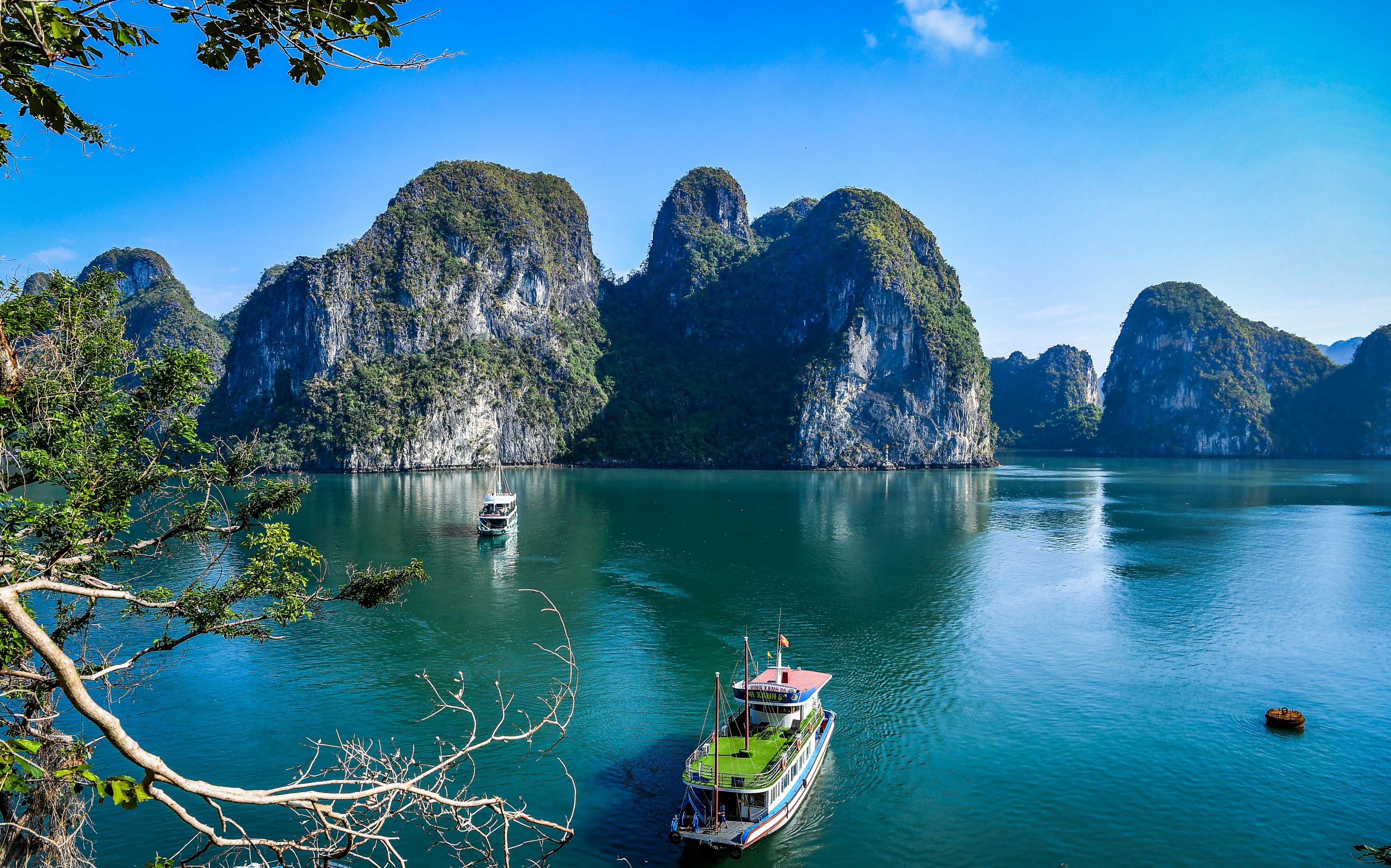
10 unique ecosystems in Ha Long Bay
In addition to its unique global geological and aesthetic values, the Ha Long Bay area currently preserves many typical ecosystems of tropical seas such as: hills, caves, mangrove forests, pine forests, coral reefs, seagrass ... Those ecosystems are distributed in an area with a relatively mild climate, average sea water temperature from 19 - 25 degrees Celsius, a very favorable living environment for living species. Those ecosystems have created a relatively outstanding biodiversity value of Ha Long Bay.
In Ha Long Bay area there exist 10 very special ecosystems of tropical limestone islands.
Vegetation ecosystem on the island
It is the habitat and development of 507 plant species (belonging to 351 genera, 110 families of vascular plants). In particular, 21 rare and endangered plant species have been recorded in the Vietnam Red Book and 17 endemic plant species have been recorded by scientists as being distributed only in the Ha Long Bay area and have not been published elsewhere.
Pine ecosystem
It is a typical and unique ecosystem of the sea area with limestone islands such as Ha Long Bay - Bai Tu Long - Cat Ba, including lakes and isolated pools on or inside the islands. The lagoon ecosystem is isolated from the outside environment, surrounded by limestone islands, on the shore are covered with vegetation, underwater is the vibrant world of marine life. The composition of animal and plant species living in the lagoons has been discovered to include 21 species of seaweed, 37 species of mollusks, 8 species of crustaceans, 6 species of echinoderms and some species of corals. These organisms have had a long time to adapt to the isolated living environment in the lagoons, so they have developed quite stably and have many species with different characteristics, endemic compared to other species outside.
Cave Ecosystem
The cave ecosystem is also a unique ecosystem of the limestone sea. The living environment in the cave often lacks light, has high humidity, poor natural food sources, and stable temperatures all year round, so the structure of the biological community is much poorer than other ecosystems, most of which are endemic species to the area. However, these are groups of organisms that are very important in studying the evolutionary process of organisms. Some typical species that have been discovered are: geckos, Ha Long cave crabs, cave carp, and snapping shrimp...
Hard-bottom intertidal ecosystem
The hard-bottom intertidal ecosystem (also known as the intertidal ecosystem of rocky reefs around the islands) is mainly intertidal flats with rocky reefs distributed around the foot of the islands in the Ha Long Bay area. The bottom is mainly cliffs, sea ridges, and in some places, pebbles and boulders sliding down from the mountains, spreading from 5 to 10 meters. Because the bottom is less changed, the environment in this ecosystem is relatively stable, with many caves and holes for shelter and hiding from enemies, so the species composition of this ecosystem is very rich and diverse with about 423 species of organisms such as seaweed, coral, snails, bivalves, reptiles, crustaceans... living and developing. Although the species composition is rich, the area is small, so the resource value (productivity) of marine organisms in this area is not high. Notably, there are Sarrgassum spp, snails, oysters, but they are only valuable for daily meals at local markets.
Soft-bottom intertidal ecosystem
The soft bottom intertidal ecosystem is the low tidal flats around the coastal islands of Ha Long Bay. Based on the characteristics of the bottom, there are 2 types: the intertidal flat type is silty sand, mud and clay adjacent to mangrove forests; the sand dune type, sand bars emerging outside the river mouth.
The low-tidal ecosystem has a complex ecological environment, changing seasonally and by time of day, according to the large tidal currents. Due to the complex environmental conditions of the estuarine soft-bottom ecosystem, the species composition of the biological community is poorer than that of the tidal zones of offshore islands. The biological community here is divided into 2 different groups: The group living permanently on the tidal flats includes benthic species; seaweed, seagrass, marine fish, and the group living in the water layer migrating with the tides including: Phytoplankton, Zooplankton, Marine fish. In addition, some vertebrate species also live and feed on the estuarine intertidal zone when the tide recedes, such as water snakes, water birds, etc.
Sand intertidal ecosystem
The sand tidal flat ecosystem is a sandy tidal flat along the hollows of small islands, some areas of sand flats are sheltered and have developed coral reefs underneath. Although the number of sand tidal flats is quite large, due to the limestone island terrain often having steep cliffs, the flats are small, steep, and composed of sand and shells of organisms such as corals, mollusks (snails, clams, mussels, etc.). The flats are often exposed at low tide. The species composition on sand tidal flats is quite poor compared to other types of ecosystems and the resource value is not high. The basic characteristic of sand tidal flats is that there is almost no zonal distribution of organisms due to unstable bottom. Some animal species found in this ecosystem are: ghost crabs, sea urchins, polychaetes, bivalves, snails, crustaceans and echinoderms, a total of 116 species of organisms have been discovered on sand tidal flats in the region.
Mangrove ecosystem
Mangrove forests are an important ecosystem, home to many valuable seafood species in the Ha Long Bay area. Ha Long Bay and its vicinity have 30 species, accounting for about 32% of the species composition of mangrove plants in Vietnam. Among the 500 species living in the mangrove forests in Ha Long Bay, there are 3 species of snails, 3 species of reptiles, 3 species of birds and 1 species of mammals listed in the Vietnam Red List, some seafood species with high economic value such as cockles, sea worms, octopus (shrimp), clams, crabs... creating unique seafood dishes in the locality.
Seagrass ecosystem
As an important marine ecosystem. Seagrass beds are the place for larvae to grow and settle for many species of shrimp, crab, and fish; at the same time, the seagrass ecosystem also plays an important role in stabilizing the bottom and treating wastewater. According to some previous studies, 5 species of seagrass have been discovered in the Ha Long - Cat Ba Bay area. However, currently the area of seagrass beds in Ha Long Bay has been greatly reduced due to sea encroachment projects, coastal areas almost no longer have seagrass beds, therefore, the value of this ecosystem cannot be promoted.
Permanent coastal wetland ecosystems
The coastal wetland ecosystem is the water surface with a depth of 0 - 20 m. This is a relatively homogeneous body of water, so the ecosystem includes many different groups of species such as phytoplankton, zooplankton, benthic animals, marine fish, reptiles, crustaceans, mollusks... Among them, many species have economic value such as sea crabs, shrimp, sea bass, ...
Coral reef ecosystem
Coral reefs in Ha Long Bay are mainly composed of hard corals. The areas with the most corals are Cong Do, Tra San, Hang Trai, Dau Be (coverage from 30% - 45%). Some marine species with important economic value live in the coral reef ecosystem such as geoducks, razor clams, groupers, pearl oysters, lobsters... In addition to species with economic value, the coral reef also has many endangered and rare species listed in the Vietnam Red List such as wrinkled propeller, spiny seahorse, Japanese seahorse, black seahorse, flat-branched horn coral, top hole coral, spiny-tailed horseshoe crab, male and female snails, spiral snails, black-lipped pearl oysters, squid, tiger cuttlefish...
Unique marine culture
Dr. Ha Huu Nga, an expert in archaeology and culture, said that in prehistoric and early historical times, the society of Ha Long-Cat Ba region was organized on the basis of communities living along the coast and islands from Hai Phong to the northeast, at least to the Ka Long estuary. It can be said that this is one of the oldest marine human ecosystems in Vietnam.
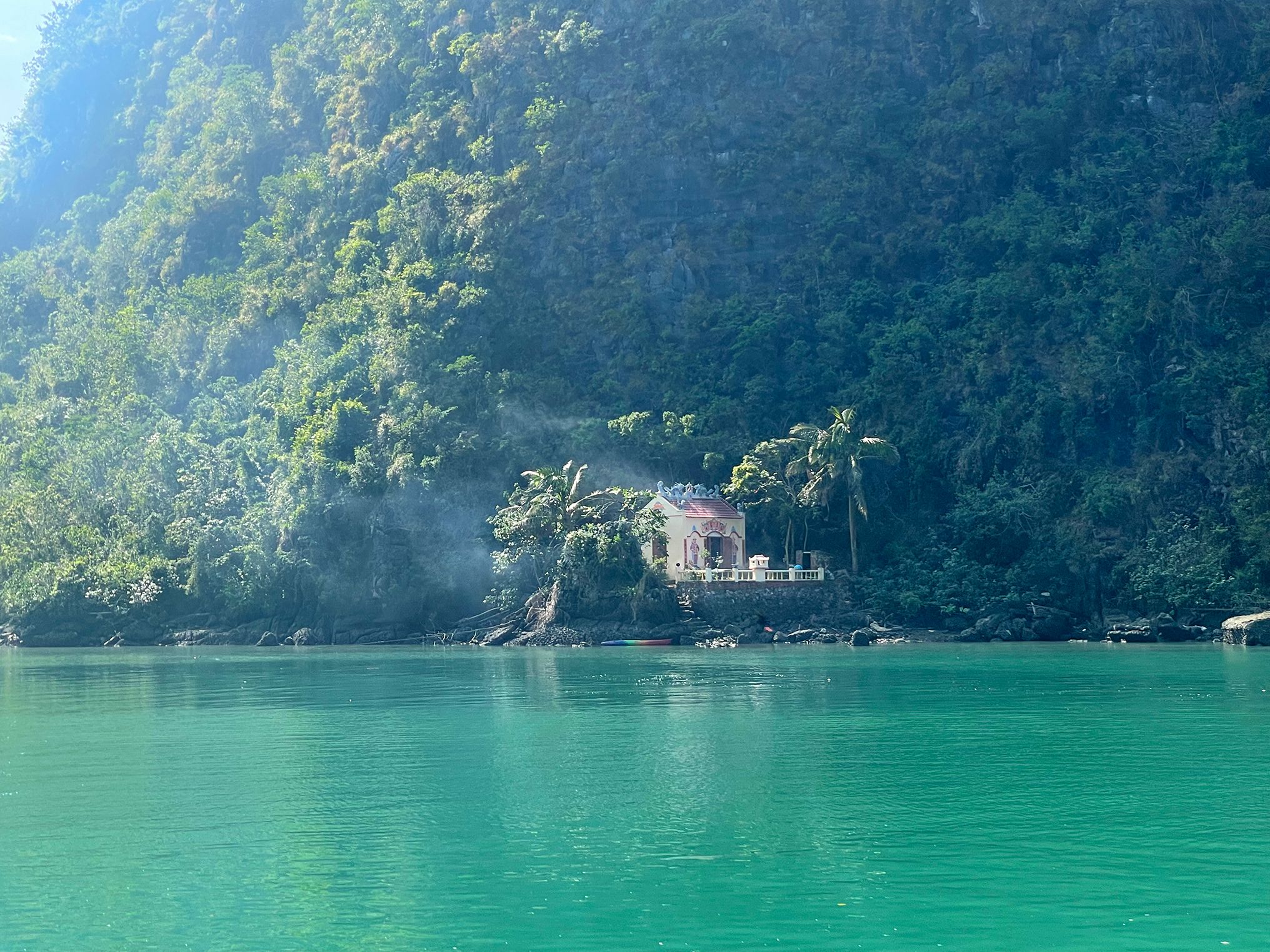
Cau Vang Temple in Cua Van.
Ha Long residents mainly settled around the Bach Dang - Chanh river estuary system, Cua Luc river estuary system, Tien Yen river estuary, Ha Coi and Ka Long, with a way of life related to forests, rivers, bays, seas... Therefore, Ha Long - Cat Ba people worship all the powers of nature, especially the sea, supernatural forces, the deceased... and consider them as powers that control their spiritual life, making them grateful, fearful, respectful and worshiping, which then became systems of beliefs, faiths and religions with their own identities.
According to Professor Nguyen Van Kim, the aquatic community is grateful to the sea gods because they provide them with a source of life. On the other hand, living by the sea, on the sea, they also have to constantly confront the unusual changes of nature. Therefore, the sea residents have a whole system of gods including Human gods, Natural gods, and Angels. Currently, the Ha Long Bay area also has many historical relics and cultural sites such as: Quan Lan Communal House, Lam Pagoda, Ba Men Temple...
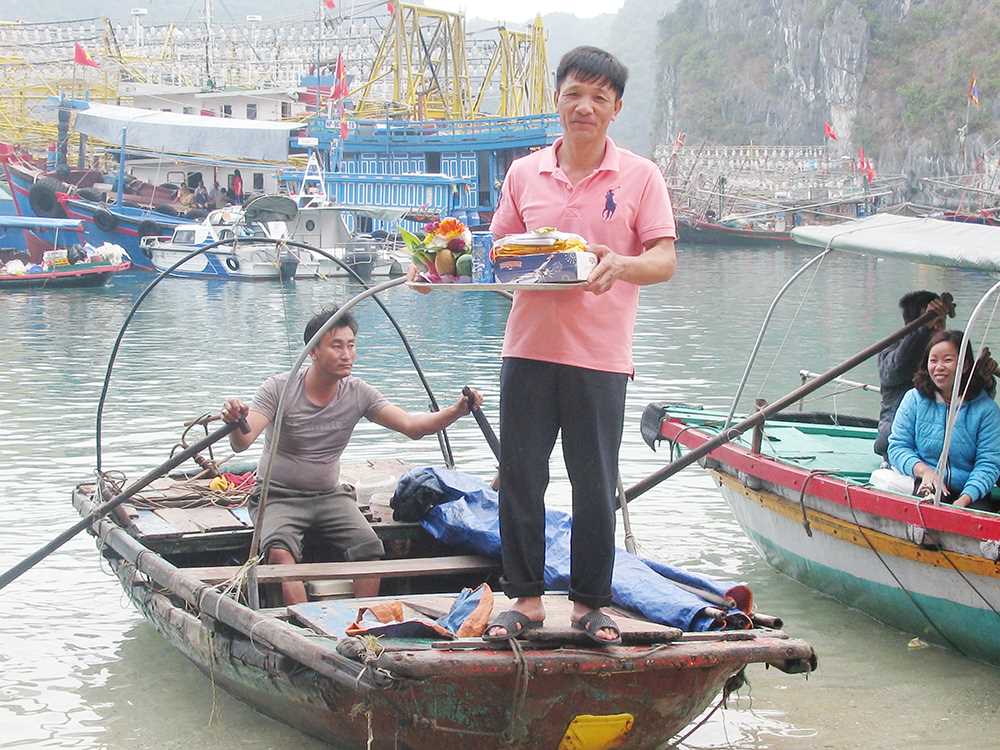
Fishermen in Ha Long Bay are preparing to pay their respects to the "river god and sea god" at the end of the year. (Photo: Quang Ninh province's electronic information portal)
In the traditions and cultural lifestyle of coastal communities, many legends about the sea are still preserved. Every year, they still organize boat racing festivals, buffalo fighting festivals, worship of Whale, Can Hai Dai Vuong, Tu Vi Thanh Nuong and many other sea gods... Those festivals, cultural activities and beliefs are not only people's reverence for the power of nature, but also a way to thank the Sea God for providing them with a source of livelihood and protecting their lives.
Professor Nguyen Van Kim believes that the residents of Ha Long - the Northeast sea islands have a rich and in-depth knowledge system about the sea. They understand the monsoon regime; the rules of tides and sea channels; about boats and boat building techniques; about fishing areas, fish flows and fishing and salt making times; about seafood processing methods and sea culinary culture; about the psychological and spiritual life of sea residents and the system of temple relics worshiping sea gods; about the sea culture (poetry, folk songs, antithetical singing at sea...); about social relationships and human responses to the sea...
In particular, the people of Ha Long coastal area still preserve unique and rich traditional cultural features from many generations, expressed through folk songs, proverbs, festivals, experiences, reflecting thoughts and feelings passed down from generation to generation.
These are intangible cultural values typical of coastal areas such as: Ho, ve, wedding songs, love songs, sea songs and many traditional rituals such as: boat-raising ceremony, tree-planting ceremony, etc.
These are typical marine cultural heritages of Ha Long - Bac Bo Gulf that were formed early in history and have been constantly supplemented and created through generations.
One of the special features of Ha Long Bay is the floating fishing villages, where residents live entirely on the water, without land. This is a unique living model of Ha Long people, considered a distinct cultural feature, closely linked to the sea and aquatic life.

Reenacting the customs of life on a boat, carried out by Cua Van Floating Cultural Center. (Photo: Bay Management Board)
These fishing villages, such as Cua Van fishing village, are not only places to live but also unique cultural spaces where generations of people have developed special community values such as close relationships between families, a spirit of mutual support, and extremely unique forms of daily life.
Floating fishing villages on the bay, such as Cua Van and Ba Hang, have existed for centuries, with their own distinctive customs, habits and traditions.
Nguyen Thi Minh, a tour guide at Cua Van Floating Cultural Center, is also one of the children of Cua Van fishing village, every day introducing the most unique cultural features of the fishing village at sea as well as the bay to domestic and international tourists.
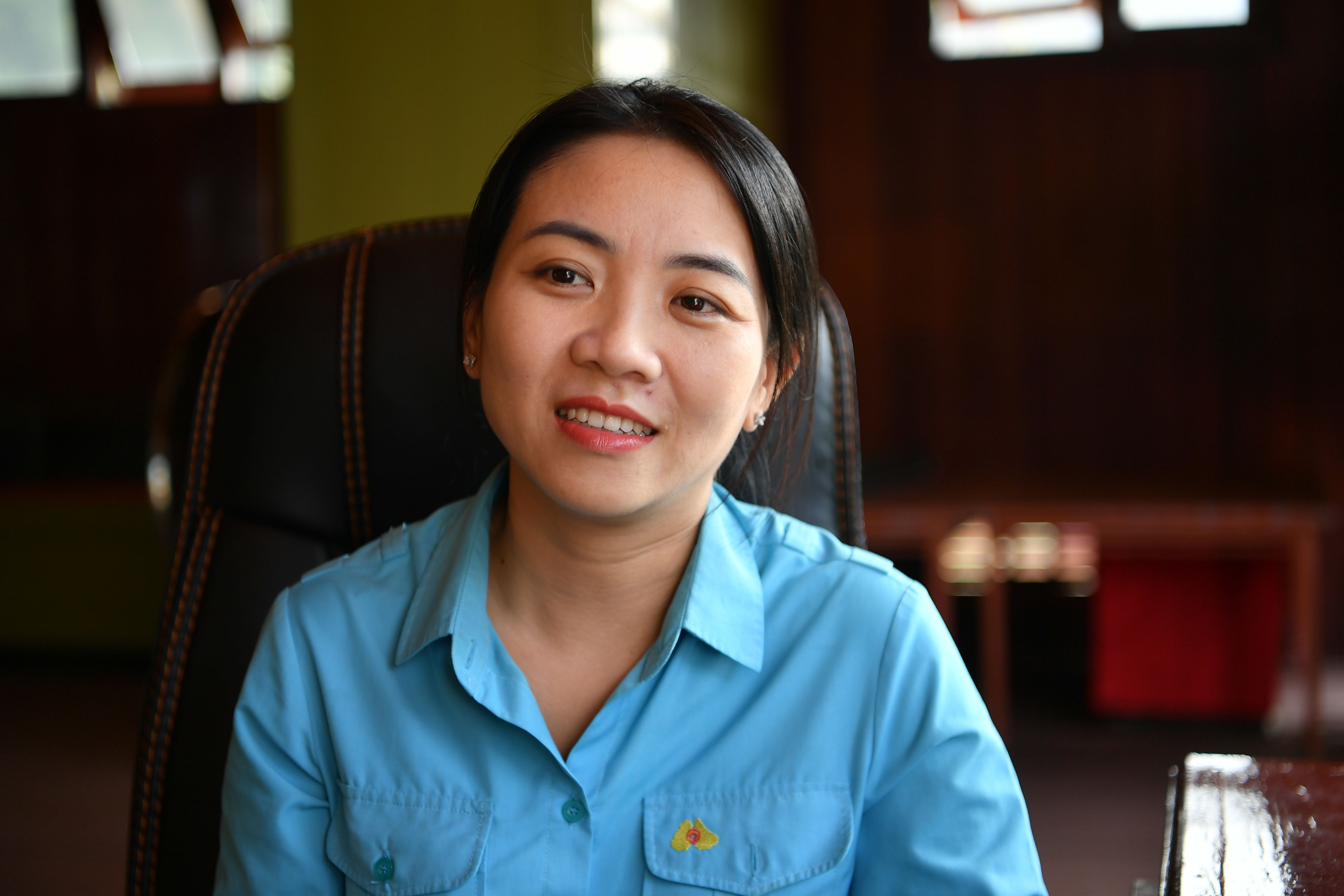
Nguyen Thi Minh, a daughter of a fishing village, tells about the unique customs of her village.
The customs of the people in the floating fishing village are what Minh finds most interesting when telling tourists, from weddings, engagements, the customs of welcoming a child, or sending off the deceased with very unique characteristics..., to the songs, folk songs in weddings, holidays, or the love songs that fishermen "chat" with each other when fishing at sea.
Nam: Above the clouds, far below the Rooster Island
He sang this line and called me out.
The words I sang yesterday
Sing again today, come out and sing together…
Female: What a beautiful boat!
The sky is not yet light, the moon is dim on the mountain top
If you have the heart, then wait.
If you love the shore, you will be anchored.
(Fishermen's antiphonal song on the Bay)
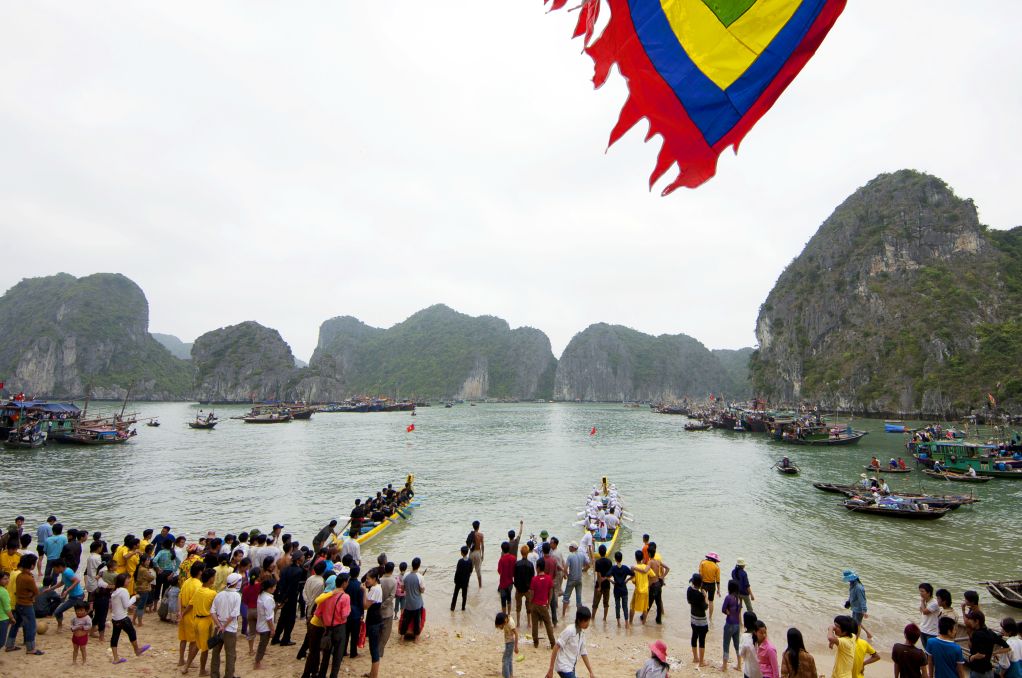
Ba Men Temple Festival in early spring. (Photo: Ha Long Bay Management Board)
In the Bay area, there are many temples representing the beliefs and spirituality of Ha Long fishermen, such as Ba Men Temple, Cau Vang Temple, and Dau Moi Temple. Every time before fishermen go fishing or have any important event, including weddings and funerals, they hold a ceremony to worship the water god, praying for everything to be good, favorable, and lucky. Every year, fishermen organize festivals such as Cau Vang Temple Festival on the 16th of April of the lunar calendar, Ba Men Temple Festival on the 19th and 20th of January every year...
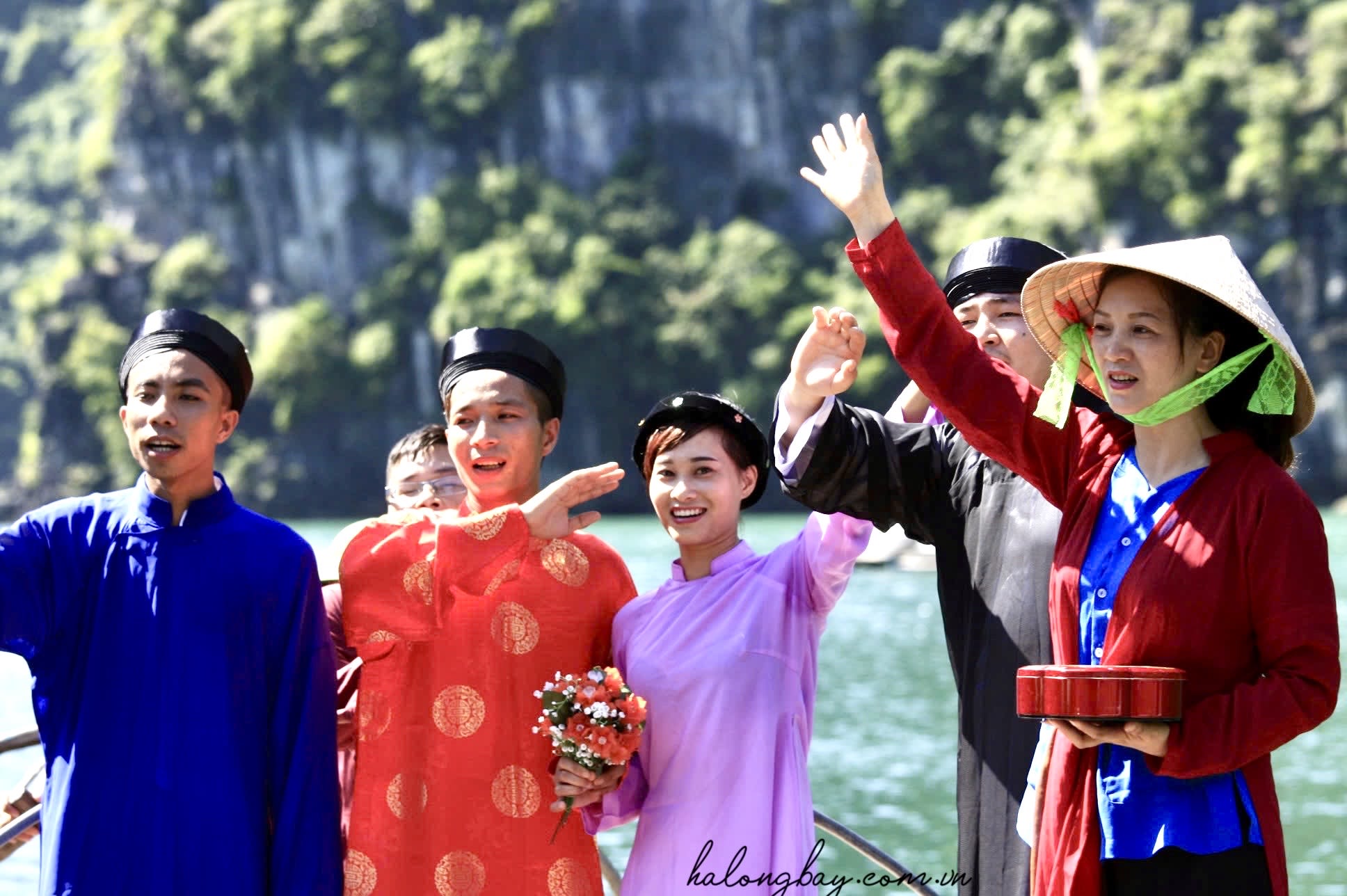
Reenacting a fishing village wedding. (Photo: Bay Management Board)
In particular, according to Nguyen Thi Minh, in the ancient fishing village of Cua Van, the customs in the rituals of life also have many differences from those on land. For example, at weddings, the groom's family wants to pick up the bride, they must sing a love duet. The bride's family will hang 3 silk strips symbolizing "3 alleys": yellow silk, green silk and red silk symbolizing "guest alley", "hanging alley", "flower alley". Therefore, the groom's family must "borrow" good singers in the village to help sing the duet, gradually removing the "alleys" hanging on the bride's boat.
In addition, fishermen are also very good at watching the sky and the earth to know the weather and the direction of the fish flow for favorable fishing.
One of the valuable folk knowledge passed down through many generations of fishermen is the folk remedies taken from plants on the high mountains in the bay. “In the past, there were no motorboats or convenient, fast means of transportation like today, so whenever fishermen were sick, they often used the local herbs to make their own remedies. These folk remedies were passed down through many generations and still exist today” – Nguyen Thi Minh said.
Ba Men Temple is located in the south of Ha Long Bay, about 30km from Tuan Chau International Passenger Port. According to Ha Long fishermen, there was a woman named Men who, while fishing, encountered a storm and capsized her boat. Her body drifted into the northwest of Dau Be Island, Ha Long Bay. The fishermen felt sorry for her and buried her and built a small temple to worship her. Since then, whoever called upon the temple for help had their prayers answered and everything went smoothly. The temple was initially just a grass-roofed shrine. In 1985, Mr. Nguyen Van Mien (Cat Ba, Hai Phong) built a more spacious temple. The temple underwent several renovations in 2006 and major repairs in 2019.
The Ba Men Temple Festival consists of two parts: ceremony and festival. The ceremony is a ritual to worship fishermen at sea; the festival includes tug of war, rowing... Before the temple festival, fishermen from everywhere come to anchor their boats in front of the temple. Every family prepares a tray of offerings to bring to the temple to burn incense with the wish for a year of peace, calm seas, and favorable business. After the ceremony, fishermen stay to cheer on the tug of war and rowing teams.
The unique cultural values of Ha Long Bay are being preserved and spread by many generations of residents, contributing to beautifying the colorful sparkle of the “precious gem” Ha Long. These values also have many interesting things to discover for researchers, those who love and honor the national cultural traditions.
New tourist attractions surveyed in Ha Long Bay
Along with the new values, many tourist attractions, landscapes including caves, islands, and new beaches have been surveyed, explored, and evaluated by the Bay Management Board for future exploitation. As Head of the Bay Management Board Vu Kien Cuong said, we have only exploited about 20% of the value of Ha Long Bay. Therefore, these newly surveyed islands are very important in enriching the beauty and attractiveness of the Bay.
Some newly surveyed caves and beaches:
Thien Long Cave is located on Dau Go island range, an archaeological relic of Soi Nhu culture (18,000 - 7,000 years ago), suitable for developing archaeological relic sightseeing services combined with experiencing the landscape and geological - geomorphological values of the cave.
Hoa Cuong Cave is located on Hon Veu, with stalactites, stone pillars, stone curtains, stalactites and cave pearls..., suitable for developing cave sightseeing services, exploring the landscape value and geological - geomorphological value of the cave.
Hanh Cave area (Hanh Cave and Hanh Cave) is located on Bom Me Island. The cave has a stalactite system. Hanh Cave is beautiful, about 14 hectares wide, is a large saltwater lake, has an underground cave connecting to the outside to Ba Cua lagoon area, suitable for developing cave tour services, exploring the ecosystem of the cave. It is possible to develop night parties in the cave if there are anchorage clusters along the shore in the future.
Ong Vung Ong is located on Ong Vung Island, with rich flora and fauna, suitable for developing eco-tourism services in Tung Ang.
Dai Thanh cave area (Dai Thanh cave and Dai Thanh 1, 2 lagoon) located on Vung Chau island, is one of the areas with high biodiversity value with typical ecosystems of tropical seas such as: Island vegetation ecosystem, regular wetland ecosystem at the foot of the island, cave ecosystem, mangrove ecosystem... Suitable for developing cave visiting services, exploring the lagoon ecosystem.
Lom Bo Island is one of the rare land islands in Ha Long Bay. Currently, the island has a rich orchard of fruit trees, ornamental plants, and timber trees. On the hillside and at the foot of the island, there is a natural sandbank, a road embankment, ornamental plants, and a natural freshwater system. On the island, there is a large-scale cave with aesthetic value, a bathing beach, suitable for developing eco-tourism, visiting caves, bathing services, and organizing snacks on the sandbank connected to the invested accommodation in the Hon Lom Bo area (about 500m away).
Dinh Thu Cave is located on Bo Hon Island, has a fairly large scale, with a system of stalactites in the cave diverse in size and shape, has high aesthetic value, suitable for developing cave visiting services in a natural form (using flashlights to explore by yourself).
Hang Trong is located on Cay Chay island, with open space, wild natural scenery, moss, ancient. Hang Trong is also an archaeological site of Soi Nhu culture (18000-7000 years). The cave floor is invested with a wooden floor system, flat.
The Virgin Cave area (Virgin Cave and Virgin Cave sandbank) is located in the Northeast of Bo Hon Island range, with beautiful scenery and pristine beaches. The cave is an archaeological site of the Ha Long culture, about 4,500 years ago.
Ho Dong Tien Cave and Ho Dong Tien Pond are located on Bo Hon Island, with a diverse system of stalactites. Going through the cave, you will reach a lake called Ang Tien, which is actually a karst funnel with the bottom flooded with seawater. Ang is discreetly surrounded by limestone mountains.
Ho Dong Tien - Hang Trinh Nu area was announced as an entertainment area on Ha Long Bay, one of 5 clusters of overnight anchorage points on Ha Long Bay.
Ang Bu Xam is located on Bu Xam island, one of the 7 conservation areas of Ha Long Bay special-use forest, suitable for developing research and study services.
Ang Du area (Ang Du and Ang Du sandbank) is located on Hang Trai island, has sand, mud sand, lots of seaweed, shrimp, fish, closed and no circulation with the surrounding environment. Here, 4 species were discovered that are only distributed in Ang Du area. In front of Ang Du is a natural sandbank, with waves all year round, open landscape, wild, untouched by humans.
Coc Cheo sandbank (in Hang Trai island area) is located on Hang Trai island, with a wild, quiet landscape, surrounded and sheltered by vertical cliffs with myriad shapes intertwined like a magical maze. The Coc Cheo sandbank area (in Hang Trai island area) is the place where famous director Jordan Vogt-Roberts chose to shoot some scenes in the Hollywood blockbuster "Kong: Skull Island".
The Ba Ham Lake area on Dau Be Island is a system of 3 sea bays with vertical walls, connected to each other in pairs through 3 narrow, winding caves like tunnels. When the tide rises, the caves are flooded, creating walls that separate the inner lakes from the outside world. This area also has an evergreen forest ecosystem on limestone mountains, characterized by drought-resistant plants, whose roots cling deep into the cracks on the vertical cliffs to grow.
Dau Be Island Sandbank, located on Dau Be Island, includes many sandbanks and is one of three operating areas for discovery cruises.
Tam Cung Cave is located on Hon 365, has a rich stalactite system, suitable for developing cave tour services in the form of self-exploration.
Vung Gianh Cave is located on the eastern side of Vung Gianh Island, with the cave floor being an ancient karst floor with accumulation of red-brown sediments; suitable for developing cave tour services.
Cap Lom Cave is located on Cap Lom Island. Traces of writing on the cave walls show that this was probably one of the starting points of the Ho Chi Minh Trail at sea during the fierce years of the war against the US.
Hon Luoi Liem sand beach is located on Hon Luoi Liem, part of the investment project to preserve and restore the coral ecosystem combined with developing ecotourism products and services, community culture in the area of Vung Ha - Bo Hung - Luoi Liem...
Source: https://special.nhandan.vn/nhung-phat-hien-moi-o-vinh-ha-long/index.html




![[Photo] Closing ceremony of the 18th Congress of Hanoi Party Committee](https://vphoto.vietnam.vn/thumb/1200x675/vietnam/resource/IMAGE/2025/10/17/1760704850107_ndo_br_1-jpg.webp)


































![[Video] Latest regulations on teacher recruitment, effective from 2026](https://vphoto.vietnam.vn/thumb/402x226/vietnam/resource/IMAGE/2025/10/17/1760715059516_gv-png.webp)
![[Photo] Nhan Dan Newspaper launches “Fatherland in the Heart: The Concert Film”](https://vphoto.vietnam.vn/thumb/1200x675/vietnam/resource/IMAGE/2025/10/16/1760622132545_thiet-ke-chua-co-ten-36-png.webp)








































































Comment (0)